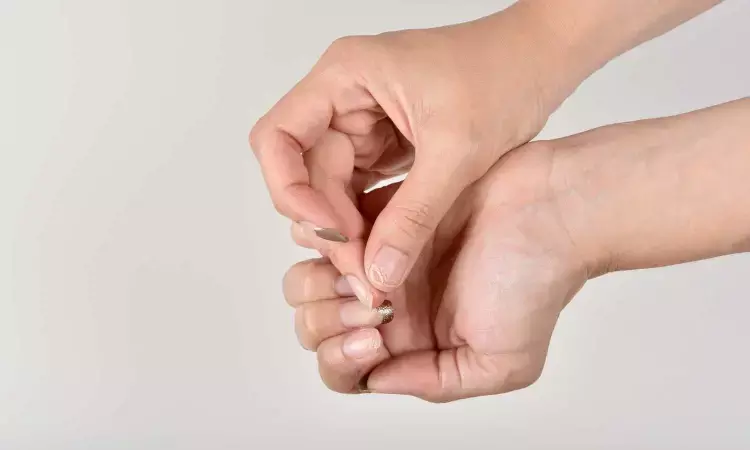- Home
- Medical news & Guidelines
- Anesthesiology
- Cardiology and CTVS
- Critical Care
- Dentistry
- Dermatology
- Diabetes and Endocrinology
- ENT
- Gastroenterology
- Medicine
- Nephrology
- Neurology
- Obstretics-Gynaecology
- Oncology
- Ophthalmology
- Orthopaedics
- Pediatrics-Neonatology
- Psychiatry
- Pulmonology
- Radiology
- Surgery
- Urology
- Laboratory Medicine
- Diet
- Nursing
- Paramedical
- Physiotherapy
- Health news
- Fact Check
- Bone Health Fact Check
- Brain Health Fact Check
- Cancer Related Fact Check
- Child Care Fact Check
- Dental and oral health fact check
- Diabetes and metabolic health fact check
- Diet and Nutrition Fact Check
- Eye and ENT Care Fact Check
- Fitness fact check
- Gut health fact check
- Heart health fact check
- Kidney health fact check
- Medical education fact check
- Men's health fact check
- Respiratory fact check
- Skin and hair care fact check
- Vaccine and Immunization fact check
- Women's health fact check
- AYUSH
- State News
- Andaman and Nicobar Islands
- Andhra Pradesh
- Arunachal Pradesh
- Assam
- Bihar
- Chandigarh
- Chattisgarh
- Dadra and Nagar Haveli
- Daman and Diu
- Delhi
- Goa
- Gujarat
- Haryana
- Himachal Pradesh
- Jammu & Kashmir
- Jharkhand
- Karnataka
- Kerala
- Ladakh
- Lakshadweep
- Madhya Pradesh
- Maharashtra
- Manipur
- Meghalaya
- Mizoram
- Nagaland
- Odisha
- Puducherry
- Punjab
- Rajasthan
- Sikkim
- Tamil Nadu
- Telangana
- Tripura
- Uttar Pradesh
- Uttrakhand
- West Bengal
- Medical Education
- Industry
Slow micrographic Surgery improves Nail Apparatus Melanoma in Situ outcome

In a recent study by Shu Zhang and peers have found that slow Mohs micrographic surgery is an effective and safe technique for treating nail apparatus melanoma in situ (NAMIS), a malignant tumor with a high incidence among Chinese melanoma patients. The findings of the study were published in .
The retrospective study, carried out between October 2016 and June 2022, enrolled ten patients diagnosed with NAMIS. Each patient underwent slow Mohs micrographic surgery, a specialized technique that allows for the precise removal of cancerous tissue while preserving as much healthy tissue as possible. Regular follow-up appointments were scheduled to monitor the patients' progress.
Among the participants, 2 patients required one Mohs stage, 7 patients underwent two stages, and one patient underwent a more extensive treatment involving seven stages. The resection margin, indicating the distance between the excised tumor and the surrounding healthy tissue, ranged from 5 to 25 mm. Importantly, no severe complications were reported during or after the treatment, demonstrating the safety of the procedure.
Furthermore, the researchers observed no recurrence of NAMIS during the follow-up period, indicating that slow Mohs micrographic surgery effectively eliminated the cancerous cells. This finding underscores the potential of this surgical method as an effective treatment option for NAMIS.
One of the notable advantages of slow Mohs micrographic surgery is its ability to preserve digit function. Given that the procedure involves the nail apparatus, which is essential for normal hand and finger movement, this aspect is crucial for patients' quality of life and overall satisfaction with the treatment. The fact that patients in the study tolerated the procedure well further supports the potential of this technique for wider clinical application.
In conclusion, the study highlights slow Mohs micrographic surgery as a valuable surgical method for treating NAMIS. With its efficacy, safety, and preservation of digit function, this technique holds promise for improving outcomes for patients with nail apparatus melanoma.
Reference:
Zhang, S., Wang, Y., Fang, K., Jia, Q., Zhang, H., & Qu, T. (2023). Slow Mohs micrographic surgery for nail apparatus melanoma in situ. In International Journal of Dermatology. Wiley. https://doi.org/10.1111/ijd.16748
Neuroscience Masters graduate
Jacinthlyn Sylvia, a Neuroscience Master's graduate from Chennai has worked extensively in deciphering the neurobiology of cognition and motor control in aging. She also has spread-out exposure to Neurosurgery from her Bachelor’s. She is currently involved in active Neuro-Oncology research. She is an upcoming neuroscientist with a fiery passion for writing. Her news cover at Medical Dialogues feature recent discoveries and updates from the healthcare and biomedical research fields. She can be reached at editorial@medicaldialogues.in
Dr Kamal Kant Kohli-MBBS, DTCD- a chest specialist with more than 30 years of practice and a flair for writing clinical articles, Dr Kamal Kant Kohli joined Medical Dialogues as a Chief Editor of Medical News. Besides writing articles, as an editor, he proofreads and verifies all the medical content published on Medical Dialogues including those coming from journals, studies,medical conferences,guidelines etc. Email: drkohli@medicaldialogues.in. Contact no. 011-43720751


